West Indian holly
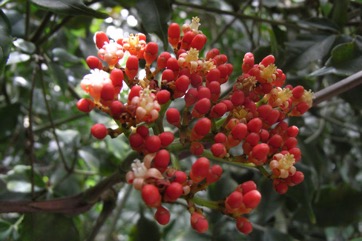
A tropical plant. It needs moderate moisture and humidity. It grows on the forest floor. It can tolerate low light. It needs moderately fertile and well-drained soil. In Nigeria it is recorded up to 1,800 m above sea level. It suits hardiness zones 10-12.
Also known as:
Amamali, Butungambole, Engachakato, Fanamboavanana, Kath thengia, Kukur-jiwa, Leea, Sengall
Synonyms
- Leea acuminata Wallich ex Clarke
- Leea coccinea Planchon
- Leea manillensis Walpers
- Leea sambucina Willd.
- and many others
Edible Portion
- Fruit, Leaves
Where does West Indian holly grow?
Found in: Africa, Angola, Asia, Australia, Bangladesh, Benin, Bhutan, Burkina Faso, Cambodia, Cameroon, Central Africa, Central African Republic, CAR, Congo DR, Côte d'Ivoire, East Africa, Equatorial-Guinea, Gabon, Ghana, Guinea, Guinée, Guinea-Bissau, Hawaii, Himalayas, India, Indochina, Indonesia, Ivory Coast, Laos, Liberia, Madagascar, Malawi, Malaysia, Micronesia, Myanmar, Mauritius, Nepal, Nigeria, Northeastern India, Pacific, Palau, Papua New Guinea, PNG, Philippines, Sao Tome and Principe, SE Asia, Sierra Leone, Taiwan, Thailand, United States, Vietnam, West Africa, Zambia
Notes: Also put in the family Leeaceae. These occur in the tropics. There are about 70 Leea species. In The Plant List Leea guineense and Leea guineensis are both accepted.
Status: It is a common tree in East New Britain in Papua New Guinea.
Growing West Indian holly
Cultivation: Plants can be grown from seed or cuttings.
Edible Uses: Caution: The juice from the berries is reported as being irritating to flesh. The ripe fruit are eaten fresh.
Production: In northeastern India they flower August to October and fruit from October to March. In Central African Republic plants have been recorded flowering and fruiting in July.
Nutrition Info
per 100g edible portion| Edible Part | Energy (kcal) | Protein (g) | Iron (mg) | Vitamin A (ug) | Vitamin c (mg) | Zinc (mg) | % Water |
|---|---|---|---|---|---|---|---|
| - | - | - | - | - | - |
West Indian holly Photos

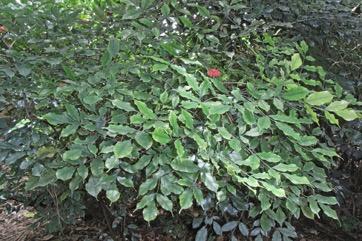
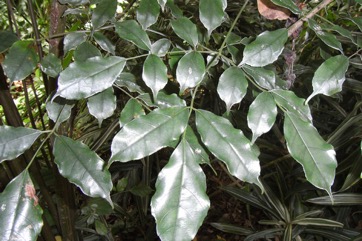
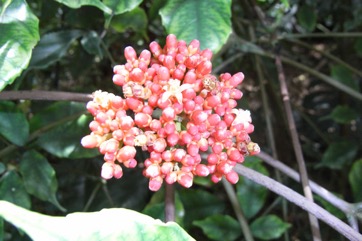
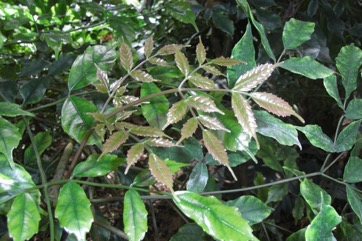
References
Abbiw, D.K., 1990, Useful Plants of Ghana. West African uses of wild and cultivated plants. Intermediate Technology Publications and the Royal Botanic Gardens, Kew. p 47
Baishya, S. Kr., et al, 2013, Survey of Wild Edible Fruits of Dhubri District, Assam, India. Plant Archives Vol 13 (1): 155-158 (As Leea acuminata)
Burkill, H. M., 1985, The useful plants of west tropical Africa, Vol. 1. Kew.
Chapman, J. D. & Chapman, H. M., 2001, The Forest Flora of Taraba and Andamawa States, Nigeria. WWF & University of Canterbury. p 181
Codjia, J. T. C., et al, 2003, Diversity and local valorisation of vegetal edible products in Benin. Cahiers Agricultures 12:1-12
Cundall, P., (ed.), 2004, Gardening Australia: flora: the gardener's bible. ABC Books. p 804
Dalziel, J. M., 1937, The Useful plants of west tropical Africa. Crown Agents for the Colonies London.
Gen. hist. 1:712. 1831
Hibbert, M., 2002, The Aussie Plant Finder 2002, Florilegium. p 180
Jardin, C., 1970, List of Foods Used In Africa, FAO Nutrition Information Document Series No 2.p 145
Kitalong, A. H., DeMeo, R. A., & Holm, T., 2013, A Field Guide to the Native Trees of Palau. 2nd edition. USDA p96
Le Houerou, H. N., (Ed.), 1980, Browse in Africa. The current state of knowledge. International Livestock Centre for Africa, Ethiopia. p 163
Llamas, K.A., 2003, Tropical Flowering Plants. Timber Press. p 245
Martin, F.W. & Ruberte, R.M., 1979, Edible Leaves of the Tropics. Antillian College Press, Mayaguez, Puerto Rico. p 225, p 197 (As Leea manillensis)
Nov. Act. Nat. Cur. 19(Suppl. 1):314. 1843 (As Leea manillensis)
Peekel, P.G., 1984, (Translation E.E.Henty), Flora of the Bismarck Archipelago for Naturalists, Division of Botany, Lae, PNG. p 349
Peters, C. R., O'Brien, E. M., and Drummond, R.B., 1992, Edible Wild plants of Sub-saharan Africa. Kew. p 120
Raponda-Walker, A & Sillans, R., 1961, Les Plantes Utiles du Gabon. Editions Paul Lechevalier, Paris. p 55
Staples, G.W. and Herbst, D.R., 2005, A tropical Garden Flora. Bishop Museum Press, Honolulu, Hawaii. p 369 (Drawing)
Terashima, H., et al, 1992, Ethnobotany of the Lega in the Tropical Rainforest of Eastern Zaire (Congo): Part Two, Zone de Walikale, African Study Monographs, Suppl. 19:1-60
Vivien, J., & Faure, J.J., 1996, Fruitiers Sauvages d'Afrique. Especes du Cameroun. CTA p 187
von Katja Rembold, 2011, Conservation status of the vascular plants in East African rain forests. Dissertation Universitat Koblenz-Landau p 171
White, F., Dowsett-Lemaire, F. and Chapman, J. D., 2001, Evergreen Forest Flora of Malawi. Kew. p 303
World Checklist of Useful Plant Species 2020. Royal Botanic Gardens, Kew